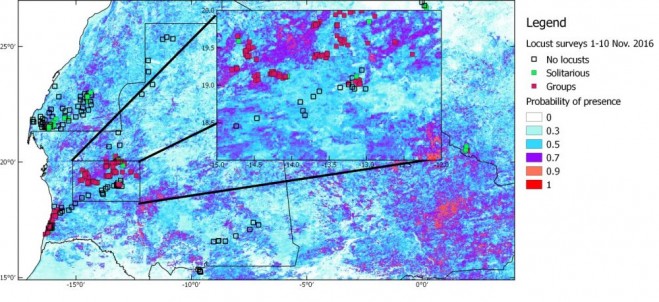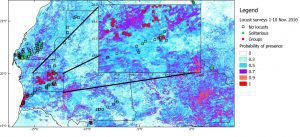

Soil moisture data from the SMOS satellite and MODIS instrument acquired between July and October 2016 were used by isardSAT and CIRAD to create this map showing areas with favorable locust swarming conditions (in red) during the November 2016 outbreak. (Credit: CIRAD, SMELLS consortium)
Satellites are helping to predict favorable conditions for desert locusts to swarm, which poses a threat to agricultural production and, subsequently, livelihoods and food security.
Desert locusts are a type of grasshopper found primarily in the Sahara, across the Arabian Peninsula and into India. The insect is usually harmless, but when they swarm they can migrate across long distances and cause widespread crop damage.
During the 2003-2005 plague in West Africa, more than 8 million people were affected. Up to 100 percent losses were reported on cereals, 90 percent on legumes and 85 percent on pasture. It took nearly $600 million and 13 million liters of pesticide to bring the plague under control.
Swarming occurs when a period of drought is followed by good rains and rapid vegetation growth. These conditions trigger a period of abundant breeding and overcrowding, and the increased contact with other locusts can lead to the formation of large swarms. This behavior makes locusts more dangerous than grasshoppers.
A 1 square-kilometer swarm contains about 40 million locusts, which eat the same amount of food in one day as about 35,000 people. In other words, a swarm the size of the capital of Mali or the capital of Niger will eat the same amount of food as half the entire population of the respective country.
Satellites can monitor the conditions that can lead to swarming locusts, such as soil moisture and green vegetation. The European Space Agency (ESA) recently teamed with international partners from Algeria, France, Mali, Mauritania, Morocco, Spain and the UN Food and Agriculture Organization (FAO) to test how data from satellites such as ESA’s Soil Moisture and Ocean Salinity (SMOS) mission can be used to predict locust plagues.
“At FAO, we have a decades-long track record of forecasting plagues and working closely with countries at greatest risk to implement control measures,” said Keith Cressman, FAO’s senior locust forecasting officer.
“By bringing our expertise together with ESA’s satellite capabilities, we can significantly improve timely and accurate forecasting. Early warning means countries can act swiftly to control a potential outbreak and prevent massive food losses.”
There are no upcoming events.
